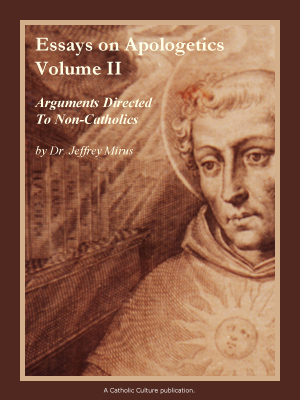The Pope’s liturgical non sequitur
By Phil Lawler ( bio - articles - email ) | Jun 29, 2022
In a pontificate marked by puzzling statements, Desiderio Desideravi, the apostolic letter on the Eucharistic liturgy released on June 29, is one of the most curious documents yet. After opening with a series of meditations on the incomparable beauty of the Eucharist, and the centrality of the liturgy to the life of faith, Pope Francis then commits a howling non sequitur, asserting—without evidence or explanation—that the liturgical changes introduced after Vatican II can alone revive the proper understanding of the Mass.
“Let us safeguard our communion,” the Pope writes in his conclusion. “Let us continue to be astonished at the beauty of the Liturgy.” No believing Catholic could possibly dissent from those aims. But nothing in this apostolic letter explains why the Pontiff believes that he advanced those aims by curbing the use of the traditional Latin liturgy.
Traditionalist Catholics are understandably dismayed by the latest papal document, because it reinforces the stern prohibitions of Traditionis Custodes. But they could turn much of the papal argument to their own advantage. If the goal is to accentuate the beauty of the liturgy and restore an awe-inspired reverence for the Eucharist—a goal that Desiderio Desideravi sets forth with admirable clarity and vigor—surely the traditional liturgy compares favorably with the Novus Ordo.
In the new document Pope Francis repeats his charge that adherence to the old liturgy is a threat to Catholic unity:
The problematic is primarily ecclesiological. I do not see how it is possible to say that one recognizes the validity of the Council—though it amazes me that a Catholic might presume not to do so—and at the same time not accept the liturgical reform born out of Sacrosanctum Concilum
Here too, traditionalists have an obvious rejoinder: The liturgy as it is experienced in a typical Catholic parish today is manifestly not faithful to the guidance that the Council Fathers put forth in that document on the liturgy. Most traditionalists would be delighted with a liturgy that reflected what the Council actually said.
The gift and the beauty
The opening section of Desiderio Desideravi, with its theological meditations on the liturgy, is powerful, at times profound and beautiful. The reader might notice that style of writing here is not similar to that of other recent papal documents. Unlike his immediate predecessors, Pope Francis has not often spoken or written on the meaning of the liturgy. And whoever helped to draft this apostolic letter took an approach quite different from that of other ghostwriters.
The title of this apostolic letter comes from a passage in the Gospel of St. Luke (22:15): “I have earnestly desired to eat this Passover with you before I suffer.” The Pope explains that in the Eucharistic liturgy, Jesus continues to share the Passover with the faithful:
If we had somehow arrived in Jerusalem after Pentecost and had felt the desire not only to have information about Jesus of Nazareth but rather the desire still to be able to meet him, we would have had no other possibility than that of searching out his disciples so that we could hear his words and see his gestures, more alive than ever. We would have had no other possibility of a true encounter with him other than that of the community that celebrates. For this reason the Church has always protected as its most precious treasure the command of the Lord, “Do this in memory of me.”
Pope Francis writes that the mission of the Church is to spread the faith in Christ so that the entire world shares in the Eucharistic banquet, embracing Christ and fulfilling his evangelical command. It is in the liturgy that the faithful experience the encounter with Christ. Therefore, the Pope writes, “With this letter I simply want to invite the whole Church to rediscover, to safeguard, and to live the truth and power of the Christian celebration.” Again no believing Catholic could demur.
However, when he turns to the topic that is the subtitle of his letter, “the liturgical formation of the People of God,” the Pope has remarkably little to say. He tells us that the manner of celebrating the liturgy should underline the meaning of the Eucharistic sacrifice, but offers no directives on how this might be done. He insists that “every aspect of the celebration must be carefully tended to (space, time, gestures, words, objects, vestments, song, music…) and every rubric must be observed,” but does not tell us which gestures, words, objects, etc. are essential. He extols the value of silence, and of symbolic gestures, but does not offer specific suggestions.
As is his wont, Pope Francis teaches by accentuating the negative, with a list of approaches that might “characterize a way of presiding that is certainly inadequate: rigid austerity or an exasperating creativity, a spiritualizing mysticism or a practical functionalism, a rushed briskness or an overemphasized slowness, a sloppy carelessness or an excessive finickiness, a superabundant friendliness or priestly impassibility.” Here yet again, traditionalists could rightly reply that many of these failings (“exasperating creativity… sloppy carelessness… superabundant friendliness”) are characteristics of the Novus Ordo rather than the traditional liturgy. Pope Benedict XVI made a similar argument, and concluded that the potential defects of the two liturgical forms could be remedied by “mutual enrichment.”
But of course Pope Francis has foreclosed that possibility, with his insistence that the Novus Ordo is the unique expression of the Roman liturgy. He refers frequently in his apostolic letter to the authority of Vatican II and of Sacrosanctum Concilium. But he glides over the reality that the liturgy as it is experienced by most Catholics today is far removed from the actual guidelines set forth in that document.
As for promoting unity within the Church, has the aftermath of Vatican II advanced that unity, when the celebration of the liturgy is markedly different from one parish to another—and often even within a parish, as different Eucharistic liturgies are scheduled to appeal to different sensibilities? Pope Francis inveighs against “a heightened personalism of the celebrating style,” yet that is too often precisely the effect wrought by the liturgical changes that have partitioned the Church in the years since Vatican II.
Embracing discontinuity
In one bid to explain why the Fathers of Vatican II saw a need to reform the liturgy, the Pope writes that modern man has lost the ability to understand the liturgy:
Therefore, the fundamental question is this: how do we recover the capacity to live completely the liturgical action? This was the objective of the Council’s reform. The challenge is extremely demanding because modern people—not in all cultures to the same degree—have lost the capacity to engage with symbolic action, which is an essential trait of the liturgical act.
If that is the case (and here I would agree with the Pope; it is), then it seems the remedy would be to help modern man regain his understanding of, and capacity for, symbolic action. So the stated goal of this apostolic letter—liturgical formation—is a good and necessary effort. Yet aside from generalities, and repeated references to the Council, the apostolic letter does not explain how we might recover what we have lost. Pope Francis exhorts the faithful to appreciate the power of liturgical gestures, including those in which the whole congregation participates (“gathering, careful walking in procession, being seated, standing, kneeling, singing, being in silence, acclamations, looking, listening”), but does not delve into the question of which gestures are appropriate, let alone explain their meaning in the context of the Eucharistic sacrifice.
For an exploration of these deeper issues, the Pope refers us to Sacrosanctum Concilium. He writes: “We owe to the Council, and to the liturgical movement that preceded it—the rediscovery of a theological understanding of the liturgy and of its importance in the life of the Church.”
To credit Vatican II with a “rediscovery” of this understanding suggests that it had been lost—not just widely misunderstood, or ignored, or even abused, but simply missing until the Council Fathers revived it. So then was all Eucharistic liturgy fundamentally flawed in the days before the Council? Here Pope Francis unambiguously embraces the “hermeneutic of discontinuity” that Pope Benedict XVI diagnosed as the main reason for misunderstanding the directives of the Council.
Thus in Desiderio Desideravi Pope Francis has contradicted the teaching of his predecessor—even more clearly than he contradicted Summorum Pontificum when he issued Traditionis Custodes. The rejection is unmistakable; nowhere in this apostolic letter does the Pope cite the work of Benedict XVI—who wrote so much and so well about the liturgy.
But if this Pope can contradict the previous Pope, then the next Pope could contradict Pope Francis. Thus one more lesson to be drawn from this apostolic letter, issued on the feast of Sts. Peter and Paul, as the Catholic world celebrates the unity of all the faithful in communion with the See of Rome.
All comments are moderated. To lighten our editing burden, only current donors are allowed to Sound Off. If you are a current donor, log in to see the comment form; otherwise please support our work, and Sound Off!
-
Posted by: IM4HIM -
Jun. 30, 2022 10:21 PM ET USA
Pope Francis is a politician and not a theologian. He says things that many people want to hear instead of preaching the faith as handed down from before. His pride has caused him to think that he knows more than his predecessors.
-
Posted by: Ken_H -
Jun. 30, 2022 6:03 PM ET USA
To me, this smacks of the US "Executive Order" situation - one administration enacts a bunch of things, presumably (and sometimes really) for the good. The next admin can just come in and undo anything, enact new things, without regard to what is good, and what is best for the people. So much for continuity and tradition - in the Church it should be even more even keeled because there is a rich tradition to fall back on. Making questionable changes is ridiculous!
-
Posted by: ewaughok -
Jun. 29, 2022 7:29 PM ET USA
Mr. Lawler has done an excellent job in discussing this uneven document of Francis. As he notes, it exhibits the hermeneutic of discontinuity common in shoddy work on Sacrosanctum Concilium. However, I think the word “contradiction“ is too strong. These are more of what Aristotle would call “contraries”. Francis documents continue to show how even Vatican publications can fail to be magisterial through errors of scholarship or logic.








